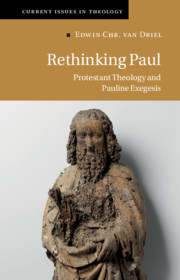Book contents
- Rethinking Paul
- Current Issues in Theology
- Rethinking Paul
- Copyright page
- Dedication
- Contents
- Preface
- Acknowledgments
- 1 The Narrative Substructure of Paul’s Thought
- 2 Justifying Faith
- 3 Jesus’ Faith
- 4 The Return of the Faithful One
- 5 Atoning Faithfulness
- 6 Resurrection and Justification
- 7 The Pauline Ordo Salutis
- 8 Church and Salvation
- 9 Christ and History
- 10 History and Israel
- 11 The Narrative of Paul’s Gospel
- 12 Doing Pauline Theology
- Epilogue
- Scriptural Index
- Subject Index
9 - Christ and History
Published online by Cambridge University Press: 06 May 2021
- Rethinking Paul
- Current Issues in Theology
- Rethinking Paul
- Copyright page
- Dedication
- Contents
- Preface
- Acknowledgments
- 1 The Narrative Substructure of Paul’s Thought
- 2 Justifying Faith
- 3 Jesus’ Faith
- 4 The Return of the Faithful One
- 5 Atoning Faithfulness
- 6 Resurrection and Justification
- 7 The Pauline Ordo Salutis
- 8 Church and Salvation
- 9 Christ and History
- 10 History and Israel
- 11 The Narrative of Paul’s Gospel
- 12 Doing Pauline Theology
- Epilogue
- Scriptural Index
- Subject Index
Summary
The relationship between Christ and history has been the point of contention between the two major exegetical conversations: the salvation-historical and apocalyptic readings of Paul. The salvation-historical tradition reads Paul as taking Christ to be the climax of God’s covenant with Israel. Christ embodies God’s faithfulness to a journey with God’s people that has stretched over ages. The apocalyptic reading of Paul conceives of Christ’s coming as an apocalyptic, disruptive invasion in this world. Both readings locate Christ and his work in the context of God’s relating to creation in reconciliation, conceiving of the difference that Christ makes as God’s response to the problems of evil and sin. This chapter argues that this betrays an ultimately deficient Christological logic. Based on Colossians and Ephesians, it is argued that Paul makes Christ also central to creation and eschatological consummation, as the pre-orderly center of all that is. This in turn offers a perspective on the relationship between Christ and history that incorporates the notions of “salvation history” and “apocalyptic revelation” in a larger, supralapsarian Christological narrative.
Keywords
- Type
- Chapter
- Information
- Rethinking PaulProtestant Theology and Pauline Exegesis, pp. 254 - 284Publisher: Cambridge University PressPrint publication year: 2021

